fuel pressure FIAT DOBLO COMBI 2018 Owner handbook (in English)
[x] Cancel search | Manufacturer: FIAT, Model Year: 2018, Model line: DOBLO COMBI, Model: FIAT DOBLO COMBI 2018Pages: 272, PDF Size: 23.75 MB
Page 49 of 272
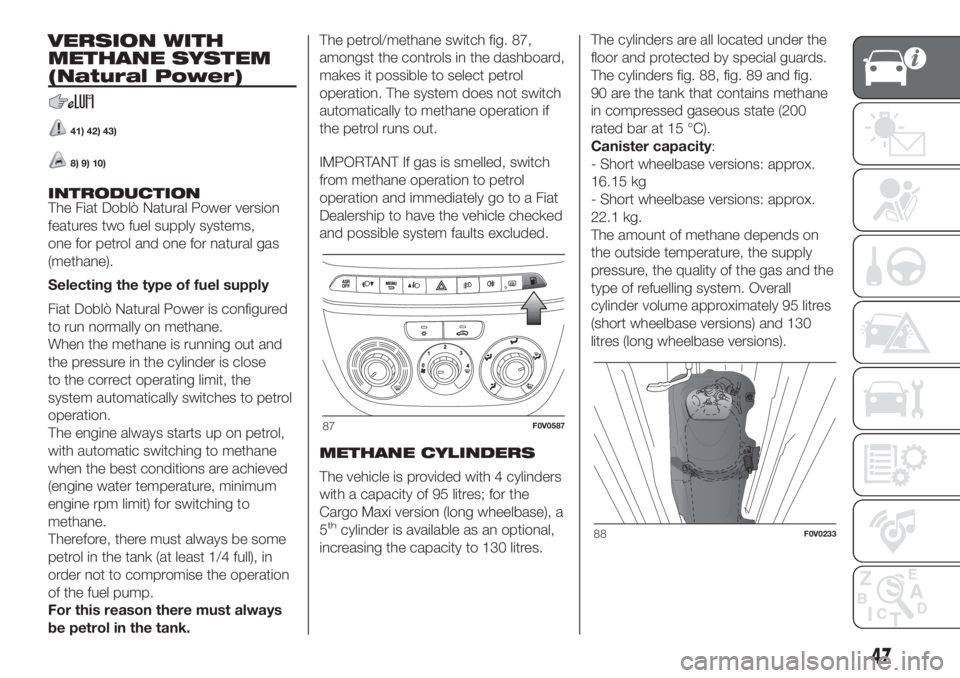
VERSION WITH
METHANE SYSTEM
(Natural Power)
41) 42) 43)
8) 9) 10)
INTRODUCTION
The Fiat Doblò Natural Power version
features two fuel supply systems,
one for petrol and one for natural gas
(methane).
Selecting the type of fuel supply
Fiat Doblò Natural Power is configured
to run normally on methane.
When the methane is running out and
the pressure in the cylinder is close
to the correct operating limit, the
system automatically switches to petrol
operation.
The engine always starts up on petrol,
with automatic switching to methane
when the best conditions are achieved
(engine water temperature, minimum
engine rpm limit) for switching to
methane.
Therefore, there must always be some
petrol in the tank (at least 1/4 full), in
order not to compromise the operation
of the fuel pump.
For this reason there must always
be petrol in the tank.The petrol/methane switch fig. 87,
amongst the controls in the dashboard,
makes it possible to select petrol
operation. The system does not switch
automatically to methane operation if
the petrol runs out.
IMPORTANT If gas is smelled, switch
from methane operation to petrol
operation and immediately go to a Fiat
Dealership to have the vehicle checked
and possible system faults excluded.
METHANE CYLINDERS
The vehicle is provided with 4 cylinders
with a capacity of 95 litres; for the
Cargo Maxi version (long wheelbase), a
5
thcylinder is available as an optional,
increasing the capacity to 130 litres.The cylinders are all located under the
floor and protected by special guards.
The cylinders fig. 88, fig. 89 and fig.
90 are the tank that contains methane
in compressed gaseous state (200
rated bar at 15 °C).
Canister capacity:
- Short wheelbase versions: approx.
16.15 kg
- Short wheelbase versions: approx.
22.1 kg.
The amount of methane depends on
the outside temperature, the supply
pressure, the quality of the gas and the
type of refuelling system. Overall
cylinder volume approximately 95 litres
(short wheelbase versions) and 130
litres (long wheelbase versions).
87F0V0587
88F0V0233
47
Page 50 of 272
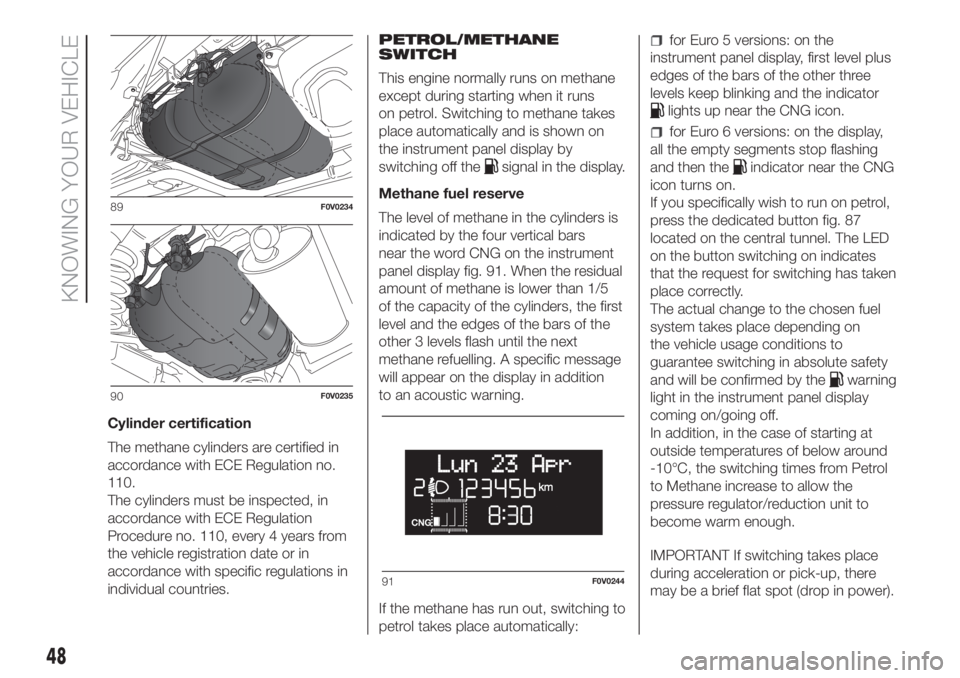
Cylinder certification
The methane cylinders are certified in
accordance with ECE Regulation no.
110.
The cylinders must be inspected, in
accordance with ECE Regulation
Procedure no. 110, every 4 years from
the vehicle registration date or in
accordance with specific regulations in
individual countries.PETROL/METHANE
SWITCH
This engine normally runs on methane
except during starting when it runs
on petrol. Switching to methane takes
place automatically and is shown on
the instrument panel display by
switching off the
signal in the display.
Methane fuel reserve
The level of methane in the cylinders is
indicated by the four vertical bars
near the word CNG on the instrument
panel display fig. 91. When the residual
amount of methane is lower than 1/5
of the capacity of the cylinders, the first
level and the edges of the bars of the
other 3 levels flash until the next
methane refuelling. A specific message
will appear on the display in addition
to an acoustic warning.
If the methane has run out, switching to
petrol takes place automatically:
for Euro 5 versions: on the
instrument panel display, first level plus
edges of the bars of the other three
levels keep blinking and the indicator
lights up near the CNG icon.
for Euro 6 versions: on the display,
all the empty segments stop flashing
and then the
indicator near the CNG
icon turns on.
If you specifically wish to run on petrol,
press the dedicated button fig. 87
located on the central tunnel. The LED
on the button switching on indicates
that the request for switching has taken
place correctly.
The actual change to the chosen fuel
system takes place depending on
the vehicle usage conditions to
guarantee switching in absolute safety
and will be confirmed by the
warning
light in the instrument panel display
coming on/going off.
In addition, in the case of starting at
outside temperatures of below around
-10°C, the switching times from Petrol
to Methane increase to allow the
pressure regulator/reduction unit to
become warm enough.
IMPORTANT If switching takes place
during acceleration or pick-up, there
may be a brief flat spot (drop in power).
89F0V0234
90F0V0235
91F0V0244
48
KNOWING YOUR VEHICLE
Page 51 of 272
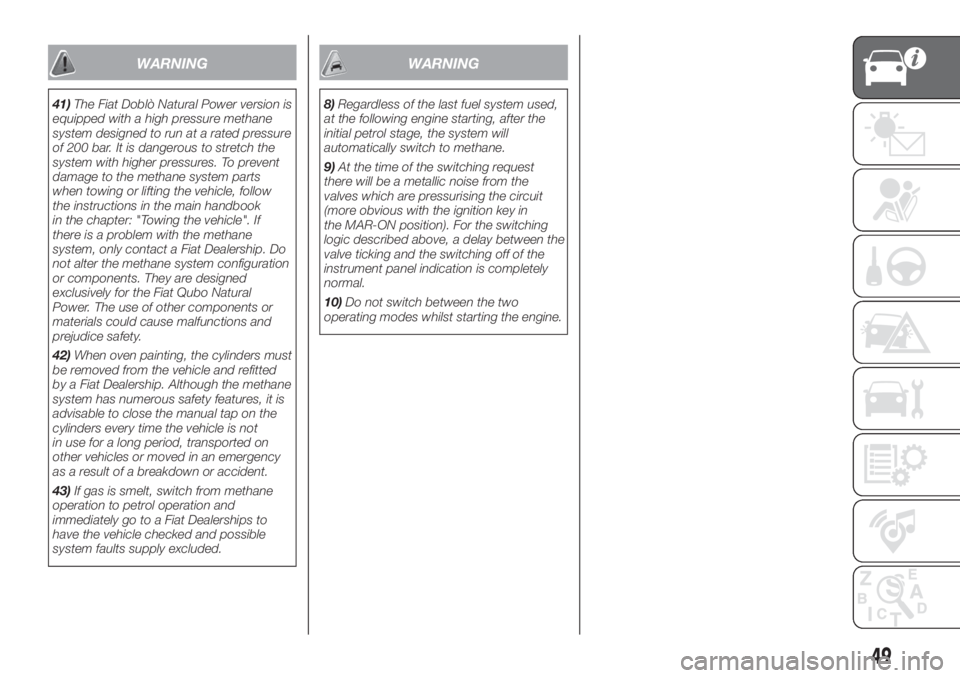
WARNING
41)The Fiat Doblò Natural Power version is
equipped with a high pressure methane
system designed to run at a rated pressure
of 200 bar. It is dangerous to stretch the
system with higher pressures. To prevent
damage to the methane system parts
when towing or lifting the vehicle, follow
the instructions in the main handbook
in the chapter: "Towing the vehicle". If
there is a problem with the methane
system, only contact a Fiat Dealership. Do
not alter the methane system configuration
or components. They are designed
exclusively for the Fiat Qubo Natural
Power. The use of other components or
materials could cause malfunctions and
prejudice safety.
42)When oven painting, the cylinders must
be removed from the vehicle and refitted
by a Fiat Dealership. Although the methane
system has numerous safety features, it is
advisable to close the manual tap on the
cylinders every time the vehicle is not
in use for a long period, transported on
other vehicles or moved in an emergency
as a result of a breakdown or accident.
43)If gas is smelt, switch from methane
operation to petrol operation and
immediately go to a Fiat Dealerships to
have the vehicle checked and possible
system faults supply excluded.
WARNING
8)Regardless of the last fuel system used,
at the following engine starting, after the
initial petrol stage, the system will
automatically switch to methane.
9)At the time of the switching request
there will be a metallic noise from the
valves which are pressurising the circuit
(more obvious with the ignition key in
the MAR-ON position). For the switching
logic described above, a delay between the
valve ticking and the switching off of the
instrument panel indication is completely
normal.
10)Do not switch between the two
operating modes whilst starting the engine.
49
Page 52 of 272
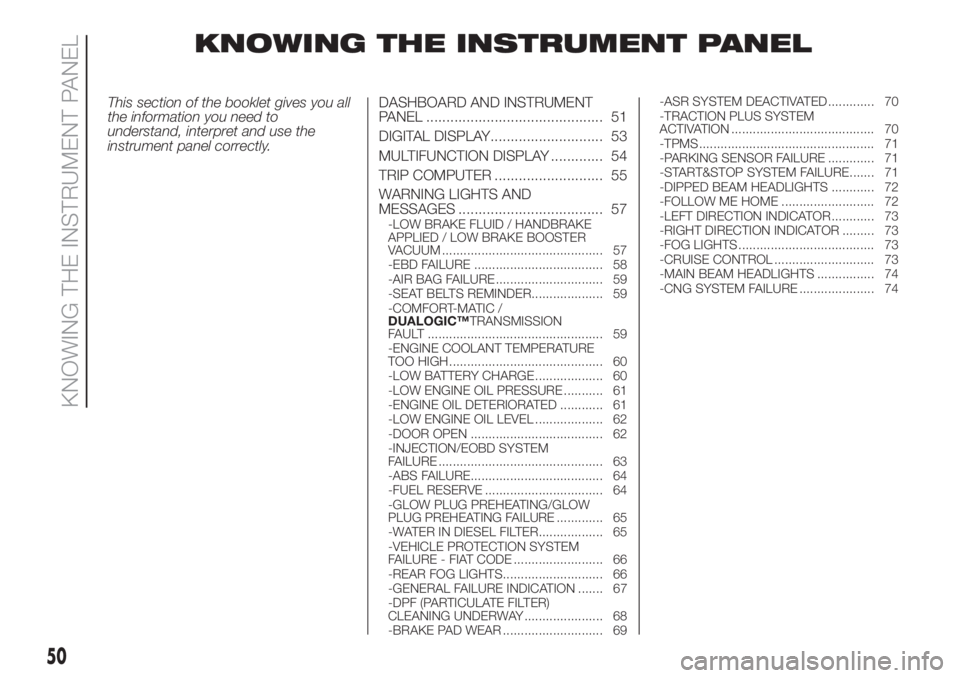
KNOWING THE INSTRUMENT PANEL
This section of the booklet gives you all
the information you need to
understand, interpret and use the
instrument panel correctly.DASHBOARD AND INSTRUMENT
PANEL ............................................ 51
DIGITAL DISPLAY............................ 53
MULTIFUNCTION DISPLAY ............. 54
TRIP COMPUTER ........................... 55
WARNING LIGHTS AND
MESSAGES .................................... 57
-LOW BRAKE FLUID / HANDBRAKE
APPLIED / LOW BRAKE BOOSTER
VACUUM ............................................. 57
-EBD FAILURE .................................... 58
-AIR BAG FAILURE .............................. 59
-SEAT BELTS REMINDER.................... 59
-COMFORT-MATIC /
DUALOGIC™TRANSMISSION
FAULT ................................................. 59
-ENGINE COOLANT TEMPERATURE
TOO HIGH........................................... 60
-LOW BATTERY CHARGE ................... 60
-LOW ENGINE OIL PRESSURE ........... 61
-ENGINE OIL DETERIORATED ............ 61
-LOW ENGINE OIL LEVEL ................... 62
-DOOR OPEN ..................................... 62
-INJECTION/EOBD SYSTEM
FAILURE .............................................. 63
-ABS FAILURE..................................... 64
-FUEL RESERVE ................................. 64
-GLOW PLUG PREHEATING/GLOW
PLUG PREHEATING FAILURE ............. 65
-WATER IN DIESEL FILTER.................. 65
-VEHICLE PROTECTION SYSTEM
FAILURE - FIAT CODE ......................... 66
-REAR FOG LIGHTS............................ 66
-GENERAL FAILURE INDICATION ....... 67
-DPF (PARTICULATE FILTER)
CLEANING UNDERWAY ...................... 68
-BRAKE PAD WEAR ............................ 69-ASR SYSTEM DEACTIVATED ............. 70
-TRACTION PLUS SYSTEM
ACTIVATION ........................................ 70
-TPMS................................................. 71
-PARKING SENSOR FAILURE ............. 71
-START&STOP SYSTEM FAILURE....... 71
-DIPPED BEAM HEADLIGHTS ............ 72
-FOLLOW ME HOME .......................... 72
-LEFT DIRECTION INDICATOR ............ 73
-RIGHT DIRECTION INDICATOR ......... 73
-FOG LIGHTS ...................................... 73
-CRUISE CONTROL ............................ 73
-MAIN BEAM HEADLIGHTS ................ 74
-CNG SYSTEM FAILURE ..................... 74
50
KNOWING THE INSTRUMENT PANEL
Page 69 of 272
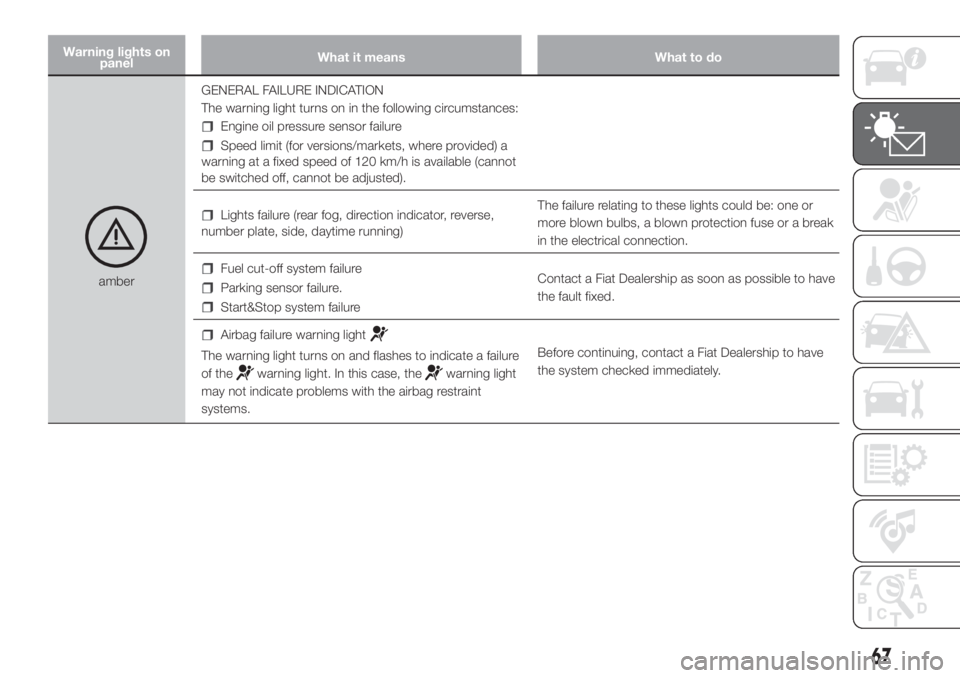
Warning lights on
panelWhat it means What to do
amberGENERAL FAILURE INDICATION
The warning light turns on in the following circumstances:
Engine oil pressure sensor failure
Speed limit (for versions/markets, where provided) a
warning at a fixed speed of 120 km/h is available (cannot
be switched off, cannot be adjusted).
Lights failure (rear fog, direction indicator, reverse,
number plate, side, daytime running)The failure relating to these lights could be: one or
more blown bulbs, a blown protection fuse or a break
in the electrical connection.
Fuel cut-off system failure
Parking sensor failure.
Start&Stop system failureContact a Fiat Dealership as soon as possible to have
the fault fixed.
Airbag failure warning light
The warning light turns on and flashes to indicate a failure
of the
warning light. In this case, thewarning light
may not indicate problems with the airbag restraint
systems.Before continuing, contact a Fiat Dealership to have
the system checked immediately.
67
Page 73 of 272

Warning lights on
panelWhat it means What to do
amberTPMS
TPMS failure
The warning light flashes for about 75 seconds then stays
on constantly when a fault is detected in the TPMS.In this case, contact a Fiat Dealership as soon as
possible.
Tyre pressure low
The warning light switches on to indicate that the tyre
pressure is lower than the recommended value and/or
that slow pressure loss is occurring. In these
circumstances, optimal tyre duration and fuel
consumption may not be guaranteed.In this case it is advisable to restore the correct
pressure value.
IMPORTANT Do not continue driving with one or more
flat tyres as vehicle handling may be compromised.
Stop the vehicle, avoiding sharp braking and steering.
Warning lights on
panelWhat it means What to do
amberPARKING SENSOR FAILURE
(for versions/markets, where provided)
The warning light turns on when failure is detected in the
parking sensors.
On some versions, the
warning light comes on
instead.
On certain versions a dedicated message is displayed.In this case, contact a Fiat Dealership.
amberSTART&STOP SYSTEM FAILURE
(for versions/markets, where provided)
The warning light comes on when a fault is detected in
the Start&Stop system.
On some versions, the
warning light comes on
instead.
On certain versions a dedicated message is displayed.In this case, contact a Fiat Dealership.
71
Page 105 of 272
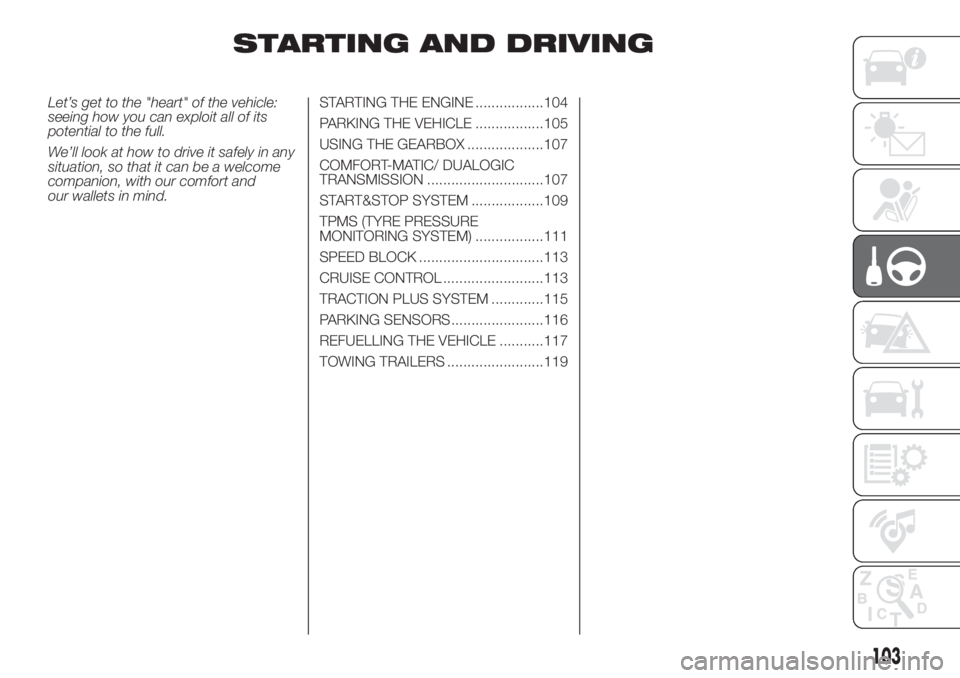
STARTING AND DRIVING
Let’s get to the "heart" of the vehicle:
seeing how you can exploit all of its
potential to the full.
We’ll look at how to drive it safely in any
situation, so that it can be a welcome
companion, with our comfort and
our wallets in mind.STARTING THE ENGINE .................104
PARKING THE VEHICLE .................105
USING THE GEARBOX ...................107
COMFORT-MATIC/ DUALOGIC
TRANSMISSION .............................107
START&STOP SYSTEM ..................109
TPMS (TYRE PRESSURE
MONITORING SYSTEM) .................111
SPEED BLOCK ...............................113
CRUISE CONTROL .........................113
TRACTION PLUS SYSTEM .............115
PARKING SENSORS.......................116
REFUELLING THE VEHICLE ...........117
TOWING TRAILERS ........................119
103
Page 113 of 272
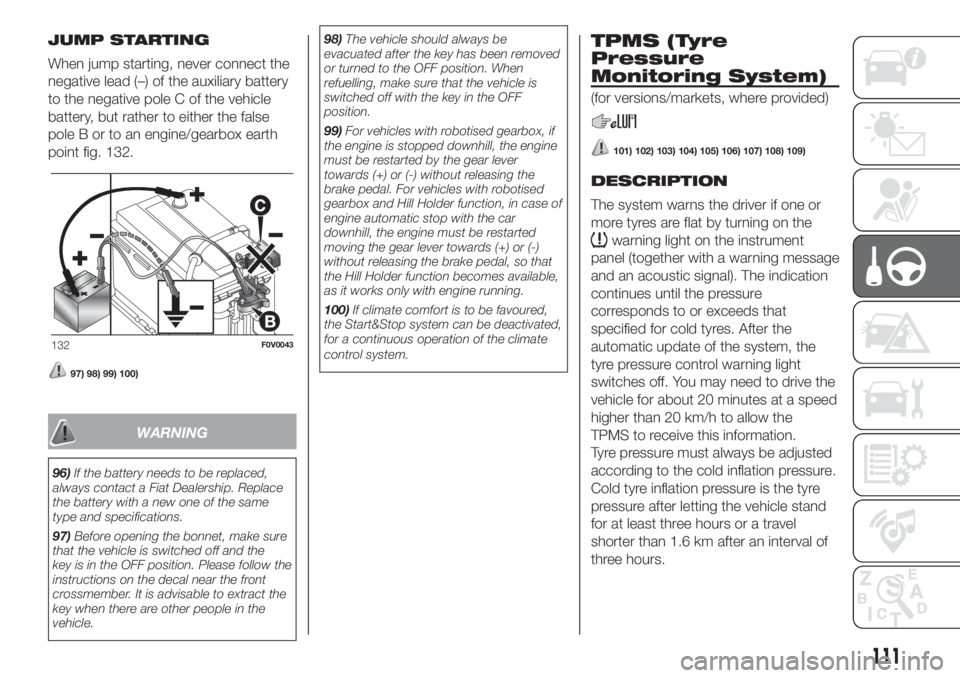
JUMP STARTING
When jump starting, never connect the
negative lead (–) of the auxiliary battery
to the negative pole C of the vehicle
battery, but rather to either the false
pole B or to an engine/gearbox earth
point fig. 132.
97) 98) 99) 100)
WARNING
96)If the battery needs to be replaced,
always contact a Fiat Dealership. Replace
the battery with a new one of the same
type and specifications.
97)Before opening the bonnet, make sure
that the vehicle is switched off and the
key is in the OFF position. Please follow the
instructions on the decal near the front
crossmember. It is advisable to extract the
key when there are other people in the
vehicle.98)The vehicle should always be
evacuated after the key has been removed
or turned to the OFF position. When
refuelling, make sure that the vehicle is
switched off with the key in the OFF
position.
99)For vehicles with robotised gearbox, if
the engine is stopped downhill, the engine
must be restarted by the gear lever
towards (+) or (-) without releasing the
brake pedal. For vehicles with robotised
gearbox and Hill Holder function, in case of
engine automatic stop with the car
downhill, the engine must be restarted
moving the gear lever towards (+) or (-)
without releasing the brake pedal, so that
the Hill Holder function becomes available,
as it works only with engine running.
100)If climate comfort is to be favoured,
the Start&Stop system can be deactivated,
for a continuous operation of the climate
control system.
TPMS (Tyre
Pressure
Monitoring System)
(for versions/markets, where provided)
101) 102) 103) 104) 105) 106) 107) 108) 109)
DESCRIPTION
The system warns the driver if one or
more tyres are flat by turning on the
warning light on the instrument
panel (together with a warning message
and an acoustic signal). The indication
continues until the pressure
corresponds to or exceeds that
specified for cold tyres. After the
automatic update of the system, the
tyre pressure control warning light
switches off. You may need to drive the
vehicle for about 20 minutes at a speed
higher than 20 km/h to allow the
TPMS to receive this information.
Tyre pressure must always be adjusted
according to the cold inflation pressure.
Cold tyre inflation pressure is the tyre
pressure after letting the vehicle stand
for at least three hours or a travel
shorter than 1.6 km after an interval of
three hours.
132F0V0043
111
Page 114 of 272

The cold tyre inflation pressure must
not exceed the maximum inflation
pressure value printed on the side of
the tyre.
NOTE
The TPMS does not replace the
normal tyre maintenance service and
does not indicate any fault in a tyre.
Therefore, the TPMS should not be
used as pressure switch while adjusting
the tyre inflation pressure.
Driving with insufficient tyre pressure
causes their overheating and can
result in tyre failure. The low inflation
pressure reduces fuel efficiency and
tyre tread life and may also affect
handling and braking performance of
the vehicle.
The TPMS does not replace the
correct tyre maintenance. It is up to the
driver to maintain the correct tyre
pressure level measuring it with
a suitable pressure switch. This is
necessary even if the decrease in the
inflation pressure value does not cause
the tyre pressure control warning light
to switch on.
The TPMS warns the driver of any
condition of insufficient tyre pressure. If
this drops below the insufficient
pressure limit for any reason including
low temperature and normal pressure
loss of the tyre.
The seasonal temperature changes
affect tyre pressure.
IMPORTANT Monitoring and
maintaining the correct pressure in all
four tyres are particularly important.
Tyre pressure monitoring system
low pressure warning
IMPORTANT In the case of deflation of
more than one tyre sequentially, without
switching off and on the engine, from
the second tyre involved the acoustic
signal is not activated, only the
dedicated signal is shown on the
display.
To prevent the signal from being stored
in the event of pressure loss of a
subsequent tyre (with deactivation of
the acoustic signal), the ignition key
must be turned to MAR and then to
STOP, each time pressure is restored.
TPMS operation faults
The system fault is indicated by the
warning light
which first flashes for
75 seconds and then stays on steadily.
WARNING
101)The TPMS is optimised for the original
tyres and wheels provided. TPMS
pressures and alerts have been defined
according to the size of the tyres mounted
on the vehicle. Using equipment with
different size, type or kind may cause
irregular system operation or sensor
damage. Non-original spare wheels can
damage the sensor. Do not use tyre
sealant or balancing weights if the vehicle
is equipped with TPMS as these may
damage the sensors.
102)If the system signals a pressure
decrease on a specific tyre, it is
recommended to check the pressure on all
four tyres.
103)The TPMS does not relieve the driver
from the obligation to check the tyre
pressure every month; it is not even to be
considered a replacing system for
maintenance or a safety system
104)Tyre pressure must be checked with
tyres cold. Should it become necessary for
whatever reason to check pressure with
warm tyres, do not reduce pressure even
though it is higher than the prescribed
value, but repeat the check when tyres are
cold.
105)The TPMS cannot indicate sudden
tyre pressure drops (for example when
a tyre bursts). In this case, stop the vehicle,
braking with caution and avoiding abrupt
steering.
112
STARTING AND DRIVING
Page 115 of 272
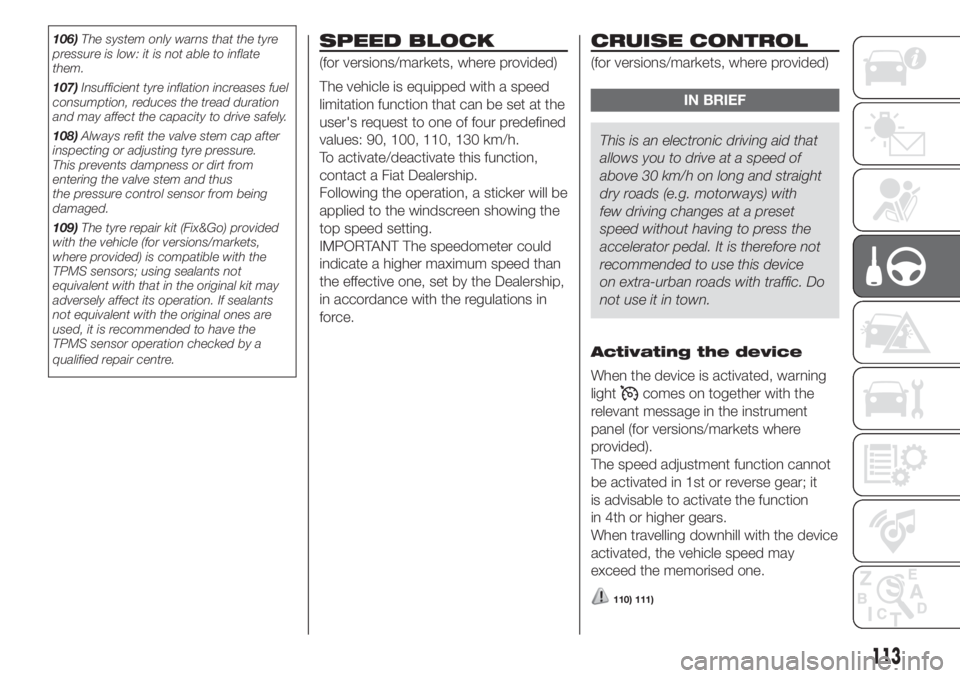
106)The system only warns that the tyre
pressure is low: it is not able to inflate
them.
107)Insufficient tyre inflation increases fuel
consumption, reduces the tread duration
and may affect the capacity to drive safely.
108)Always refit the valve stem cap after
inspecting or adjusting tyre pressure.
This prevents dampness or dirt from
entering the valve stem and thus
the pressure control sensor from being
damaged.
109)The tyre repair kit (Fix&Go) provided
with the vehicle (for versions/markets,
where provided) is compatible with the
TPMS sensors; using sealants not
equivalent with that in the original kit may
adversely affect its operation. If sealants
not equivalent with the original ones are
used, it is recommended to have the
TPMS sensor operation checked by a
qualified repair centre.SPEED BLOCK
(for versions/markets, where provided)
The vehicle is equipped with a speed
limitation function that can be set at the
user's request to one of four predefined
values: 90, 100, 110, 130 km/h.
To activate/deactivate this function,
contact a Fiat Dealership.
Following the operation, a sticker will be
applied to the windscreen showing the
top speed setting.
IMPORTANT The speedometer could
indicate a higher maximum speed than
the effective one, set by the Dealership,
in accordance with the regulations in
force.
CRUISE CONTROL
(for versions/markets, where provided)
IN BRIEF
This is an electronic driving aid that
allows you to drive at a speed of
above 30 km/h on long and straight
dry roads (e.g. motorways) with
few driving changes at a preset
speed without having to press the
accelerator pedal. It is therefore not
recommended to use this device
on extra-urban roads with traffic. Do
not use it in town.
Activating the device
When the device is activated, warning
light
comes on together with the
relevant message in the instrument
panel (for versions/markets where
provided).
The speed adjustment function cannot
be activated in 1st or reverse gear; it
is advisable to activate the function
in 4th or higher gears.
When travelling downhill with the device
activated, the vehicle speed may
exceed the memorised one.
110) 111)
113